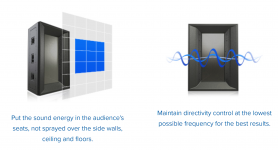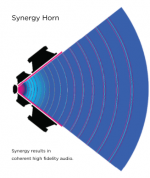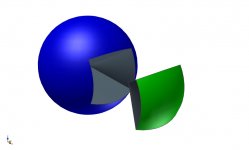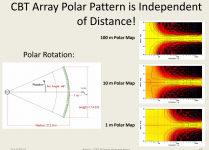Without including references to the information you are referring to makes it impossible to guess at what they said that made you think that.Both Toole and Linkwitz think lower attenuation/distance is better for home theater. You don't think it matters as much, which is fine. I think their arguments are compelling.
In practical terms it is an issue for maximum loudness in that you need more output at the speaker to deal with the inverse square attenuation. It would take quite an array to get near to the Hyperion's 124dB output level.
As an example at 8 meters the Hyperion would be making 106dB, for an array to match it at that distance would require the array to be 115dB at 1m.
So certainly it reduces the level required at the source but it's easier to get a horn to 124dB than an array to 115dB across it's entire bandwidth.
So how far you will listen and how many rows of seats are to be included will determine if it matters much in the average home theatre.
A cylindrical surface is curving across one direction where a spherical one is curving across all directions. Inverse vs inverse squared.I don't understand why you think a horn is different from an array in terms of drop-off/distance. Does the surface area of expansion suddenly explode?
If a horn was different to a direct radiator in terms of distance attenuation then it would make building a 2 way horn direct radiator speaker quite difficult as above and below the crossover they would function differently with distance.
Can we stop now?
Last edited:
Sure, stop.
For anyone else who is interested, Floyd Toole discusses the value of reduced attenuation/distance in home theater here:
And Keele's related note:
Toole also explains it in chapter 14.2.3 of his book.
Linkwitz mentions it here:
An omnidirectional source radiates into a sphere. The energy (sound level) is distributed over the surface of an expanding sphere. That geometry causes the inverse square relationship over distance (-6dB). A horn, in contrast, is not an omnidirectional source within its frequency control range.
Danley doesn't show a bubble floating out the front of their horn. Does anyone else see a bubble floating out the end of their horn and subsequently radiating into a sphere in the attached image?
For anyone else who is interested, Floyd Toole discusses the value of reduced attenuation/distance in home theater here:
"If a variation of this design or something else entirely, can come close to this performance target in a real room, the result would be a remarkable improvement in spatial and directional effects for the entire room. It is probable that fewer surround loudspeakers would be needed for large audiences."
And Keele's related note:
(Note by Don Keele Oct. 2011: The CBT36 would work superbly in this application. The pair of systems should be mounted upside down on the ceiling on either side of the video room and aimed cross fired into the room. For optimum results, the ears of the listeners should be in an approximate range that extends from the bottom of the hanging array (its top) to a point two feet lower. This would effectively equalize level variations across a 10 to 15 foot wide listening room!)
Toole also explains it in chapter 14.2.3 of his book.
"A more elegant solution is to use loudspeakers having less than inverse square loss per double distance, such as line sources, see Section 10.5.2 or other array designs such as CBTs shown in Figure 9.13f and g, which would logically be inverted to use the ceiling as the adjacent boundary. Other CBT configurations can be found in the JBLPro product line, and these have found use as surround loudspeakers. Suitably configured, these loudspeakers can deliver a relatively constant sound level over much of an audience."
Linkwitz mentions it here:
"SPL falls off at a low rate with distance (3 dB/oct) and is nearly constant over a distance range. This is ideal for a home theater setup with rows of seats. (SL)"
An omnidirectional source radiates into a sphere. The energy (sound level) is distributed over the surface of an expanding sphere. That geometry causes the inverse square relationship over distance (-6dB). A horn, in contrast, is not an omnidirectional source within its frequency control range.
Danley doesn't show a bubble floating out the front of their horn. Does anyone else see a bubble floating out the end of their horn and subsequently radiating into a sphere in the attached image?
Attachments
None of the above quotes is in any way contradictory to the information I gave.
Here's another one of a Synergy and now it has a curve to it

That image looks like a Jericho which would have some line features due to the paraline of tweeters and other drivers funnelling into a horn with greater vertical dimensions. I doubt they thought anyone would take it as you did.Danley doesn't show a bubble floating out the front of their horn. Does anyone else see a bubble floating out the end of their horn and subsequently radiating into a sphere in the attached image?
Here's another one of a Synergy and now it has a curve to it
Attachments
Bradley,
Sure, a horn isn't an omni. Actually the most easy way to look at it could be as a part of a spherical shape. Much like one cuts piece of pie, but in 2 directions.
In the Hypherion this 'piece of the pie' is 'a cut' of 60 x 60 degree.
As the output will grow, both in horizontal and vertical direction the further out you go, it has the same properties (within that piece) as a total sphere would have.
Hence it will drop 6 dB for each doubling of distance.
Just look at the image posted by fluid. Both the top view and side view would show that same behavior. Does that make it more clear?
I'll show a 60 x 60 degree part of a sphere:

Due to the controlled pattern (less energy hitting the walls etc.), it will have a higher direct to indirect sound ratio, which would be good for HT.
Sure, a horn isn't an omni. Actually the most easy way to look at it could be as a part of a spherical shape. Much like one cuts piece of pie, but in 2 directions.
In the Hypherion this 'piece of the pie' is 'a cut' of 60 x 60 degree.
As the output will grow, both in horizontal and vertical direction the further out you go, it has the same properties (within that piece) as a total sphere would have.
Hence it will drop 6 dB for each doubling of distance.
Just look at the image posted by fluid. Both the top view and side view would show that same behavior. Does that make it more clear?
I'll show a 60 x 60 degree part of a sphere:
Due to the controlled pattern (less energy hitting the walls etc.), it will have a higher direct to indirect sound ratio, which would be good for HT.
Attachments
Hey guys, thanks for posting those. I think the misunderstanding is that shape causes attenuation rather than surface area.
wesayso's image shows surface area so it's easier to demonstrate. Cut three slices of the extracted 60 degree section and sum the surface areas. Then cut three slices of a full sphere and sum the surface areas. That tells you which surface area increases at the greater rate.
WRT attenuation over distance the shape doesn't matter the increase in surface area matters. Do you spread the energy out over a larger surface area or a smaller surface area over distance?
Don Keele's papers calls these things a spherical "cap" (so does geometry but Keele is more immediately relevant). Here's a Keele powerpoint presentation.
Both the physically curved and the time delayed CBTs generate the same shape. However, the monopole CBT narrows the vertical without narrowing the horizontal. Side note: one advantage with a straight DSP CBT is that you can easily adjust delay and shading to control vertical beam coverage. Anyway, you can see how the shape of Keele's CBT radiation looks similar to Fluid's image. Again, it isn't about shape it's about surface area expansion.
In previous posts, there was a question about how far an array can hold its pattern (i.e. 3dB drop-off over distance) so I included Keele's slide 66. Also, if you read through Keele's slides you can see why you don't need a floor to ceiling array in a small room.
wesayso's image shows surface area so it's easier to demonstrate. Cut three slices of the extracted 60 degree section and sum the surface areas. Then cut three slices of a full sphere and sum the surface areas. That tells you which surface area increases at the greater rate.
WRT attenuation over distance the shape doesn't matter the increase in surface area matters. Do you spread the energy out over a larger surface area or a smaller surface area over distance?
Don Keele's papers calls these things a spherical "cap" (so does geometry but Keele is more immediately relevant). Here's a Keele powerpoint presentation.
Both the physically curved and the time delayed CBTs generate the same shape. However, the monopole CBT narrows the vertical without narrowing the horizontal. Side note: one advantage with a straight DSP CBT is that you can easily adjust delay and shading to control vertical beam coverage. Anyway, you can see how the shape of Keele's CBT radiation looks similar to Fluid's image. Again, it isn't about shape it's about surface area expansion.
In previous posts, there was a question about how far an array can hold its pattern (i.e. 3dB drop-off over distance) so I included Keele's slide 66. Also, if you read through Keele's slides you can see why you don't need a floor to ceiling array in a small room.
Attachments
Last edited:
I'm a little dubious about the claim keeping energy off the walls is good for home theater. That may or may not be true but I haven't seen compelling argument.
If you can't have a center channel for some reason maybe keeping reflections off the walls would be good, but that's a strange limitation given the likely cost of the Danleys. You wouldn't want to eliminate the center channel by choice because then you wouldn't be able to reduce the L/R channel volume relative to the center to improve dialog intelligibility for older ears -- or just because you don't want the obnoxiously loud mix some action movies use.
At present, lower attenuation rate over distance seems to be the comparative advantage of the horns here. Of course, I could be wrong.
If you can't have a center channel for some reason maybe keeping reflections off the walls would be good, but that's a strange limitation given the likely cost of the Danleys. You wouldn't want to eliminate the center channel by choice because then you wouldn't be able to reduce the L/R channel volume relative to the center to improve dialog intelligibility for older ears -- or just because you don't want the obnoxiously loud mix some action movies use.
At present, lower attenuation rate over distance seems to be the comparative advantage of the horns here. Of course, I could be wrong.
But for making a factual point i busted on, pls accept my apology bradleypnw
No problem.
I'm not sure if this will help you but the "Laws of Light" section has a diagram and an explanation, the ones below have plenty of mathematical explanations.Hey guys, thanks for posting those. I think the misunderstanding is that shape causes attenuation rather than surface area.
Inverse Square Law - an overview | ScienceDirect Topics
There are many ways to get to a similar result. A floor to ceiling array generally uses a single amplifier and takes up virtually no floor space. It can be passively frequency shaded if desired too. A straight delay shaded line can approximate a CBT in the same footprint but at the cost of DSP and amplifiers. A CBT as Keele makes them takes up a lot of floor space. They are all good options and have their own benefits and trade offs.Also, if you read through Keele's slides you can see why you don't need a floor to ceiling array in a small room.
However, the monopole CBT narrows the vertical without narrowing the horizontal.
I should have emphasized this for jarvissound in the original post but I'll do it here. That's cylindrical shape you're thinking about. But remember, it's not shape it's area growth over distance that matters in attenuation.
The maximum attenuation you can get is a growing sphere. That's why the terms "point source" and "omnidirectional" are used when discussing the inverse square law and -6dB/doubling.
An expanding cylinder adds less surface area than a sphere as you expand. That's why arrays don't attenuate as rapidly as an omnidirectional point source.
It isn't an advantage because it doesn't happen. Test it for yourself if you need to, buy or borrow a horn and measure it at 1m and 2m.At present, lower attenuation rate over distance seems to be the comparative advantage of the horns here. Of course, I could be wrong.
I could run the test if that would help to convince you.
The horn works as a section of a sphere so that section still expands in direct proportion to the full sphere with distance and attenuates at the same rate as the full sphere with distance.An expanding cylinder adds less surface area than a sphere as you expand. That's why arrays don't attenuate as rapidly as an omnidirectional point source.
The horn works as a section of a sphere so that section still expands in direct proportion to the full sphere with distance and attenuates at the same rate as the full sphere with distance.
Look at wesayso's image. A point source in the center generating a specified SPL. Spread that energy out over the entire sphere. Then spread that energy out over the extracted section. Which surface area is larger and spreads the energy out more?
The surface area of the sphere grows at a much faster rate than the extracted wedge.
You guys don't have to build CBTs if you don't want to. CBTs just demonstrate you don't need a floor to ceiling array.
You seem to be regarding it as some form of competition which is the opposite of the point I am trying to make. All the practical array options aim at basically the same thing. The only bad choice is a short straight array with no form of shading used full range, beyond that they all perform well. Available space, desired level of electronic complexity, looks etc. then inform which option any one person might choose for themselves.
Maybe it's easier to think of it as a cube?
A cube has six sides. Pretend a point source radiates into a cube shape. It radiates into an area of six.
Now the horn only radiates into one side of the cube. It radiates into an area of one.
Grow the cube and you can see how the surface area of the cube grows much faster than the surface area of a single side. In other words, your attenuation is more rapid with a growing cube than a growing side.
Does that make it clearer?
A cube has six sides. Pretend a point source radiates into a cube shape. It radiates into an area of six.
Now the horn only radiates into one side of the cube. It radiates into an area of one.
Grow the cube and you can see how the surface area of the cube grows much faster than the surface area of a single side. In other words, your attenuation is more rapid with a growing cube than a growing side.
Does that make it clearer?
The surface area of the sphere grows at a much faster rate than the extracted wedge.
To work out the rate of expansion of the wedge you must compare the wedge at one point to the wedge at another point.You know what, maybe you aren't comparing the rate of the sphere expansion to the rate of the wedge expansion. You don't compare the wedge to the wedge.
The sphere is -6dB. The wedge is less.
When you compare like to like you will find that that the rate of change is the same which is why they respond the same in this way even though they are different in others.
The rate of change from cube to cube at a distance is the same as the rate of side to side at the same distance.Grow the cube and you can see how the surface area of the cube grows much faster than the surface area of a single side. In other words, your attenuation is more rapid with a growing cube than a growing side.
Does that make it clearer?
Comparing the cube to the side is why you think differently to every other person in this thread who has tried to explain it.
You don't compare the rate of change of a side to a side, you compare the rate of change of a side to a whole cube. The cube grows six times faster than a side.
A growing cube attenuates at -6dB. That's the absolute maximum that a sound can attenuate because it is the maximum surface area. A growing side attenuates less than -6dB because it is a smaller surface area.
A growing cube attenuates at -6dB. That's the absolute maximum that a sound can attenuate because it is the maximum surface area. A growing side attenuates less than -6dB because it is a smaller surface area.
Last edited:
We tried really hard here Bradley, supplied an easy to understand image and even quoted Danley's own website. We can't make it any clearer than this, the part of the sphere drops as fast as the sphere. If there weren't drivers dangling on the outside one could build a complete sphere from a number of Synergies. In fact, to get bigger coverage angles that's exactly what Danley does.
- Home
- Loudspeakers
- Multi-Way
- Danley Signature Series




